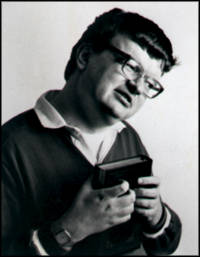
Asperger syndrome (AS), also known as Asperger's, is a former neurodevelopmental disorder characterized by significant difficulties in social interaction and nonverbal communication, along with restricted and repetitive patterns of behaviour and interests. The syndrome is no longer recognised as a diagnosis in itself, having been merged with other disorders into autism spectrum disorder (ASD). It was considered to differ from other diagnoses that were merged into ASD by relatively unimpaired spoken language and intelligence.

Savant syndrome is a rare condition in which someone with significant mental disabilities demonstrates certain abilities far in excess of average. The skills that savants excel at are generally related to memory. This may include rapid calculation, artistic ability, map making, or musical ability. Usually, only one exceptional skill is present.

Nobody Nowhere: The Extraordinary Autobiography of an Autistic Girl is the award-nominated debut book by Australian Donna Williams. It was initially published in Britain in 1992, and was on the New York Times Best Seller list for 15 weeks in the first half of 1993.

Donna Leanne Williams, also known by her married name Donna Leanne Samuel, was an Australian writer, artist, singer-songwriter, screenwriter, and sculptor.
Anthony John Attwood is a British psychologist notable for his work on Asperger syndrome. He resides in Queensland, Australia, where he is an Associate Professor at Griffith University.

Monotropism is a cognitive strategy posited to be the central underlying feature of autism. A monotropic mind is one that focuses its attention on a small number of interests at any time, tending to miss things outside of this attention tunnel. The theory of monotropism was developed by Dinah Murray, Wenn Lawson and Mike Lesser starting in the 1990s, and published about in the journal Autism in 2005. Wenn Lawson's further work on the theory formed the basis of his PhD, Single Attention and Associated Cognition in Autism, and book The Passionate Mind.

Somebody Somewhere is a book written by the autistic author, songwriter, screenwriter and artist Donna Williams. It is the 1994 sequel to the bestseller Nobody Nowhere, which spent 15 weeks on the New York Times Bestseller List.
High-functioning autism (HFA) is an autism classification where a person exhibits no intellectual disability, but may exhibit deficits in communication, emotion recognition and expression, and social interaction. HFA is not included in either the American Psychological Association's DSM-5 or the World Health Organization's ICD-10, neither of which subdivides autism based on intellectual capabilities.
The following outline is provided as an overview of and topical guide to autism:

The University of North Carolina TEACCH Autism Program creates and disseminates community-based services, training programs, and research for individuals of all ages and skill levels with autism spectrum disorder (ASD), to enhance the quality of life for them and their families across the lifespan.
Jacqueline Carol Jackson is a British writer who consults, counsels, speaks and writes on most autism issues. Her doctoral thesis, entitled 'Nurturing the Engagement of Children with an Autism Spectrum Disorder through Digital Polysensory Experiences', awarded from Coventry University, analysed the sensory differences of children with an ASD and the impact of the digital and built environment. Jackson is a single mother of eight children, three daughters and five sons, of whom all five sons and one daughter are on the autism spectrum. Jackson and her family appeared in a BBC documentary titled My Family and Autism in 2003. A drama film called Magnificent 7 starring Helena Bonham Carter as Maggi, a character based on Jackson, aired on BBC Two in 2005. Jackson lives in Blackpool.

Self-stimulatory behavior, also known as "stimming" and self-stimulation, is the repetition of physical movements, sounds, words, moving objects, or other repetitive behaviors. Such behaviors are found to some degree in all people, especially those with developmental disabilities, and are especially frequent in people on the autism spectrum. People diagnosed with sensory processing disorder are also known to potentially exhibit stimming behaviors. Stimming has been interpreted as a protective response to overstimulation, in which people calm themselves by blocking less predictable environmental stimuli, to which they have a heightened sensitivity. A further explanation views stimming as a way to relieve anxiety and other negative or heightened emotions. Although some stimming behaviors are very beneficial at times, stimming has been highly stigmatized and dramatized. People who are neurodivergent often feel that they need to hide or decrease their self-stimulatory behavior, as it often elicits an undesirable response from those who do not understand the compulsion behind them. There are also potential mental health and well-being risks in suppressing stimming.
Jessica Kingsley Publishers (JKP) is an independent, multinational publishing house headquartered in London, and founded in 1987 by Jessica Kingsley.
Peter Szatmari is a Canadian researcher of autism and Asperger syndrome.

Autistic art is artwork created by autistic artists that captures or conveys a variety of autistic experiences. According to a 2021 article in Cognitive Processing, autistic artists with improved linguistic and communication skills often show a greater degree of originality and attention to detail than their neurotypical counterparts, with a positive correlation between artistic talent and high linguistic functioning. Autistic art is often considered outsider art. Art by autistic artists has long been shown in separate venues from artists without disabilities. The works of some autistic artists have featured in art publications and documentaries and been exhibited in mainstream galleries. Although autistic artists seldom received formal art education in the past, recent inclusivity initiatives have made it easier for autistic artists to get a formal college education. The Aspergers/Autism Network's AANE Artist Collaborative is an example of an art organization for autistic adults.

Societal and cultural aspects of autism or sociology of autism come into play with recognition of autism, approaches to its support services and therapies, and how autism affects the definition of personhood. The autistic community is divided primarily into two camps; the neurodiversity movement and the Pathology paradigm. The pathology paradigm advocates for supporting research into therapies, treatments, and/or a cure to help minimize or remove autistic traits, seeing treatment as vital to help individuals with autism, while the neurodiversity movement believes autism should be seen as a different way of being and advocates against treatments, therapies or a cure, seeing it as trying to exterminate autistic people and their individuality. Both are controversial in autism communities and advocacy which has led to significant infighting between these two camps. While the dominant paradigm is the pathology paradigm and is followed largely by autism research and scientific communities, the neurodiversity movement is highly popular within autism advocacy and autism rights organizations.
Pathological demand avoidance (PDA) is a profile of autism spectrum disorder and a proposed sub-type. Characteristics ascribed to the condition include greater refusal to do what is asked of the person, even to activities the person would normally like, due to extreme levels of anxiety and lack of autonomy. Although PDA has its own traits that are separate from autism, they generally meet the diagnostic criteria by having significant impairments in social interaction and communication and presenting restricted and repetitive behaviors. Some notable differences in PDA compared to classic autism spectrum disorders are that individuals appear to be more sociable, have far better social skills and social understanding, tend to be more interested in people than objects, are more comfortable with pretend play, and tend to be more imaginative. It is not recognized by either the DSM-5 or the ICD-10 and is unlikely to be separated out now that the umbrella diagnosis of ASD has been adopted.
Autism-friendly means being aware of social engagement and environmental factors affecting people on the autism spectrum, with modifications to communication methods and physical space to better suit individual's unique and special needs.
Gunilla Gerland is a Swedish author and lecturer on the topic of autism.
Low-functioning autism (LFA) is a degree of autism marked by difficulties with social communication and interaction, challenging behavior, and differences in social or emotional reciprocity. Sleep problems, aggression, stereotypical, and self-injurious behavior are also common symptoms. LFA is not a recognized diagnosis in the DSM-5 or ICD-10, as neither subdivides autism based on intellectual capabilities.










